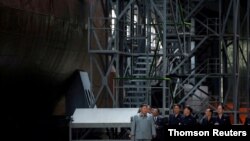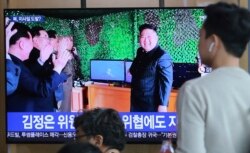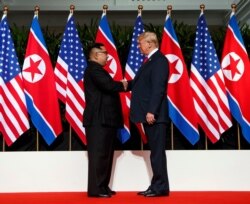This story was last updated on July 23 at 7:30 a.m.
Juhyun Lee contributed to this report.
It’s not a missile launch or a nuclear test. But Kim Jong Un’s unveiling of a new submarine is the latest way North Korea appears to be pressuring the United States, as working-level nuclear talks struggle to get off the ground.
North Korean state media on Tuesday published pictures of Kim inspecting an imposing, newly built submarine, saying the vessel will soon be deployed in the waters off Korea’s east coast.
"[Kim] expressed great satisfaction over the fact that the submarine was designed and built to be capable of fully implementing the military strategic intention of the Party under various circumstances," reported the official Korean Central News Agency.
Although the article didn’t say what kind of weapons the submarine would carry, the reference to "strategic" capabilities implied the vessel could handle nuclear-capable missiles for strategic deterrence purposes.
The new submarine is a reminder that North Korea continues to develop and diversify its weapons program, amid yet another delay in nuclear talks with the United States.
Unpredictable new threat
The development of submarine-launched ballistic missiles, or SLBMs, would add an unpredictable new component to North Korea’s arsenal. SLBMs are mobile, potentially increasing the range of North Korea's ballistic missile arsenal. They are also easier to hide.
"ICBMs were for responsiveness and range, SLBMs are for survivability," tweeted Vipin Narang, a nuclear expert and professor at the Massachusetts Institute of Technology.
Following several failed tests, North Korea in 2016 successfully tested a ballistic missile launched from an experimental Gorae-class submarine.
Several reports, based partly on commercially available satellite images, have suggested North Korea was working on a new, larger class of submarine that could fire several SLBMs.
The submarine unveiled Tuesday appears to confirm those reports, according to many analysts. Other analysts said the new vessel may be from one of North Korea's existing class of submarines that has been modified to carry ballistic missiles.
"It seems like a 3000-ton submarine that can house three to four submarine-launched ballistic missiles," says Park Won-gon, a professor at Handong Global University.
“It is well-known that submarines are hard to defend against. It is a kind of ultimatum when it comes to having nuclear power abilities,” Park says.
Increased leverage?
The submarine rollout appears to be North Korea’s latest attempt to increase its leverage in nuclear talks with the United States.
In May, North Korea launched several short-range ballistic missiles and other projectiles — its first ICBM launches in a year and a half.
Last week, North Korea threatened to resume long-range ballistic missile launches, as well as nuclear tests, if the U.S. and South Korea go ahead with a planned joint military exercise expected to begin next month.
U.S. President Donald Trump has not commented on the submarine, but he has shrugged off the other North Korean provocations, suggesting he’s in no hurry for a deal.
By unveiling the submarine, North Korea is "obviously to put pressure on the U.S.," says Shin Beom-chul, senior analyst at Seoul's Asan Institute for Policy Studies. But he says the North Korean provocations appear to be carefully calibrated.
"Neither the U.S. nor North Korea will stop the talks, even though North Korea may try to improve its bargaining position," he says.
No timetable for talks
Trump on Monday acknowledged there is no timetable for resuming working-level negotiations.
White House officials had spoken of a breakthrough after Kim and Trump agreed to restart talks during a hastily arranged meeting last month at the demilitarized zone separating the two Koreas.
U.S. Secretary of State Mike Pompeo on Monday said he hopes the working-level talks will begin “in a couple of weeks.” Pompeo had previously said he thought the talks would start around the middle of July.
Over a year into Trump’s outreach to Kim, U.S. officials acknowledge the two sides haven’t even agreed on what the idea of denuclearization means. Asked about that disagreement Monday, Pompeo pushed back.
“I’ve talked to Chairman Kim about this many, many times. [There is] absolute clarity. There’s no dispute,” Pompeo said.
“This is the fully denuclearized, verified effort that we have been talking about for all of this time,” Pompeo said. “I hear people talk about whether there’s ambiguity. There’s no ambiguity.”
North Korea has set an end-of-the-year deadline for the U.S. to make more concessions in the talks.









